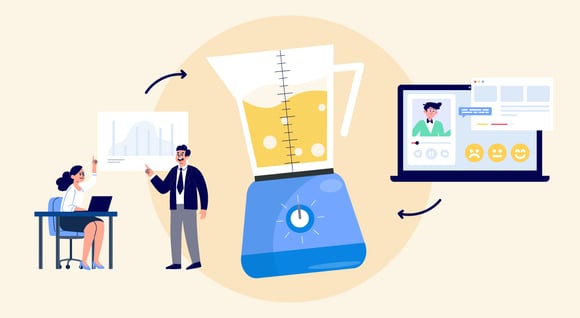Blended Learning mixes the best from the worlds of learning. Learn about the pros, cons, and how to get started here.
Blended Learning mixes the best from the worlds of learning and development – here, you can really do the learning magic. The most common understanding of Blended Learning is to combine face-to-face learning activities and digital learning activities. Before we go into this deep dive about blended learning, let us sum blended learning up for you:
Blended Learning Sum-up
-
Blended Learning taps into different learning styles and increases learning output
-
Great flexibility for the learners to learn wherever and whenever it suits them
-
Use of different learning activities empowers learning efficiency
-
Watch out for the ‘e-learning trap’ with dull Powerpoint-slides and long PDF-files
-
Don’t underestimate the power of Social Learning
-
What learning activities and content fit with your type of learners?
-
Identify learning barriers in your organization
-
Create the best and most versatile learning flow
-
Mix up different learning activities and don’t be afraid to use yourself in the context
One of the key concepts about Blended Learning is, that it appeals to different learning styles. Meaning that there is room for those who learn best in a classroom, where you have to listen, reflect, and discuss. And, of course, there is also room for those who prefer the flexibility to sit for themselves and take the learning course online – whenever it suits them.
It is the combination of the hands-on and the digital, which fit with different learning styles – and that makes the learning more engaging and effective. Let’s zoom in on the pros and cons of Blended Learning.
The pros and cons of Blended Learning
The pros of Blended Learning line up, but only if you avoid the pitfalls. A clear advantage is, that Blended Learning meets the user's needs to get learning served in different ways – both hands-on and in a digital universe.
Furthermore, flexibility is a great advantage. The digital types of learning are available when the user has the time, the need, and the motivation to learn the new.
Different Learning Activities
At last, it is more efficient to learn like this, because Blended Learning empowers a lot of different learning activities, which enable the learners to learn in their best way. For example, if the time at the course is only spent by the instructor next to the board, while he or she loads a lot of new knowledge on the learners. Instead, a lot of this unloading of knowledge can happen digitally with the use of podcasts and videos, while the time spent in the classroom is only for discussions, reflections, and how to interpret the learning in real-life scenarios.
Variation, flexibility, and the right use of learning activities are great advantages of Blended Learning.
The eLearning Trap
The pros can easily be overshadowed by the cons. First and foremost, when the digital part becomes too dull and monotonous.
We often see it in the ‘e-learning trap’, where all of the knowledge smashes into the same Powerpoint-slideshow or loooong PDF-file, and now it is up to the learners to fight their way through the wall of text.
The consequence is that the learners will bore themselves to death – and the learning output will dramatically decrease.
Here, it is important, that we think about different types of learning activities such as videos, podcasts, learning games, quizzes, etc.
Another pitfall is when technology is the only thing in sight. And you are blown away by all the new and sparkling.
It is easy to underestimate, how important it is for the learners to think about what they’ve learned, to reflect, discuss, and challenge each other on specific perceptions. Meaning: Don’t forget the social aspect of learning.
This can, of course, also be done in a digital setting, but for the learning to be most efficient, we also need to discuss it face-to-face.
Know Your Learners
Furthermore, it is important to identify what learning activities and content fit with certain types of people. Often, we teach in a classroom, because it is the easiest thing to do in our own opinion.
But it is not always the most appropriate strategy – or the strategy that gives the best learning outcome. We can avoid this pitfall if we adapt the learning materials, time optimizes in the classroom, and find out what elements we can digitalize. Now, we only need to focus on how to use this knowledge in your company.
How to use Blended Learning in your organization
As we’ve already put into words: The potential of Blended Learning is great. It can do your training more engaging, motivating, and efficient – and if you do it right, it is often cheaper than exclusively using face-to-face training in a classroom.
A good place to start is if you identify the learning barriers that can stop Blended Learning in your organization.
Furthermore, look into the best possible option to make a versatile learning flow in your organization.
A final piece of advice is to mix up the types of learning activities. Grab your smartphone, make a small intro movie, or find a cool video on YouTube on the subject. The new professional communication is personal communication, so don’t be afraid to put yourself or your teachers out there. The learners will love it.

